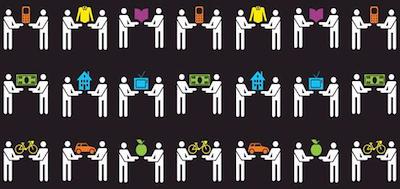A few years ago, Lawrence Lessig, ethicist and professor at Harvard Law, sat down in an airline seat next to a young man with a vast collection of pirated DVDs. Confounded and out of reading material, Lessig ultimately wound up asking his seat mate if he’d rent him one. Insulted, the young man said he’d lend a DVD, but never for money. Lessig, in telling the story, goes on to explore how our relationships with each other and with material things can come in different forms — some things you expect to pay for, and some are given freely. The distinctions for “which is which?” go to the center of how a culture works.
“There exists not just the commercial economy, which meters access on the simple metric of price, but also a sharing economy, where access to culture is regulated not by price, but by a complex set of social relations. These social relations are not simple.” (Lessig)
An even more precise analysis comes from the work of UCLA anthropologist Alan Fiske, who developed Relational Model Theory to determine four essential types of relationships from which he believes all human interactions are composed – buying, bartering, freely sharing, and commanding (or yielding).
The internet is a deep pool of both commercialized and non-commercialized interactions and so has become a huge experiment in how we ethically engage with each other — that’s Lessig’s fascination. We’re also in a period when entire business models are being built on internet-facilitated sharing, whether for price (like AirBnB) for barter (yerdle, OurGoods) or simple good will (couchsurfing).
The movement has its journal, Shareable — which positions the sharing economy as the solution to intractable global problems:
“What’s the sharing transformation? It’s a movement of movements emerging from the grassroots up to solve today’s biggest challenges, which old, top-down institutions are failing to address.
Behind these failing industrial-age institutions are outmoded beliefs about how the world works – that ordinary people can’t govern themselves directly; that nonstop economic growth leads to widespread prosperity; and that more stuff leads to more happiness.”
The idea of a sharing movement is idealistic, but increasingly backed by real numbers in participation (and by decades of research questioning the utility of materialism).
Children are inundated with the values of sharing from a young age, constantly reminded to share their most valuable possessions with friends and peers. As adults, these skills are re-imagined for social participation, yet discarded in the conventional economy. If kids are urged to share, why shouldn’t adults do the same?
The “shareable community,” as one of its many names, presents a community structure with two main components: social relationships and economic practices. Organizations and companies are emerging across the globe that cultivate and strengthen sharing practices in order to promote community building and sustainability.
The shareable community works off of principles of supply and demand, tracing human need in a way that makes it all the more appealing and easy to gain membership. The result of these sharing practices, however, is a large network of social relationships that satisfy both the economic and social self and produce physical manifestations of reciprocity and trust. At its core, the sharing economy is about building connections with people.
[pullquote align=”right”]Children are taught to share.[/pullquote]
The movement has many names: the sharing economy, collaborative consumption, and the community economy – names for a new development of a very old idea. Sharing and gift giving remain the foundation of community life in many cultures. The rapid growth of new forms of sharing, in urban America specifically, is largely due to the internet; social networking websites are intrinsically tied to the way that the shareable community runs since most, if not all, organizations are run through an online platform. However, sharing practices are not meant to remain isolated in online behavior.
With the increasing publicity and knowledge surrounding the shareable movement, it has begun to seep into other aspects of daily life such as the way people conceive of participation more generally. An original hope of many of the online-based companies was that it would begin to change behavior offline. Lessig goes on to explain the prevalence of online platforms for sharing:
“The Internet is filled with successful sharing economies, in which people contribute for reasons other than money…We’re living in a time when technology is favoring the social. More vibrant sharing economies are the result.”
[pullquote align=”left”]Is it possible to translate online sharing programs into off-line social behavior?[/pullquote]
What does it mean for technology to favor the social? And is it possible to translate online sharing programs into off-line social behavior? In examining the varying programs that have emerged out of the movement, it becomes increasingly clear that this hope is not quite as far-fetched as was once imagined.
Earlier in City Atlas, we took a look at car sharing at SXSW, a conference on building a new economy, the Solidarity map of NYC, a Chicago barter network that is no more — a reminder that new economies need to scale to prosper. On our following post, we learn about a new barter network just fully unveiled: yerdle, from San Francisco.
